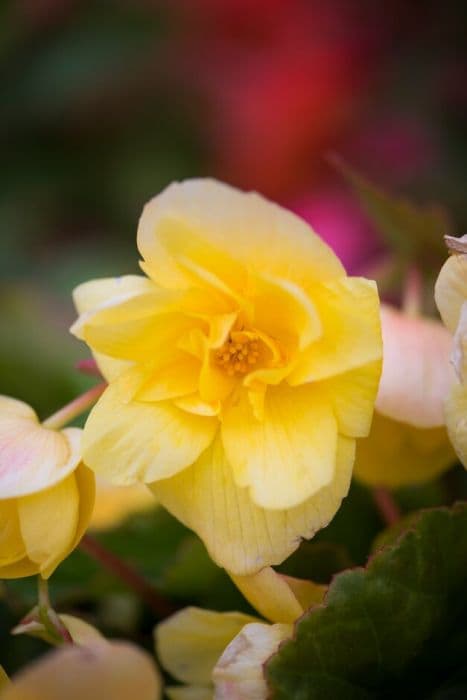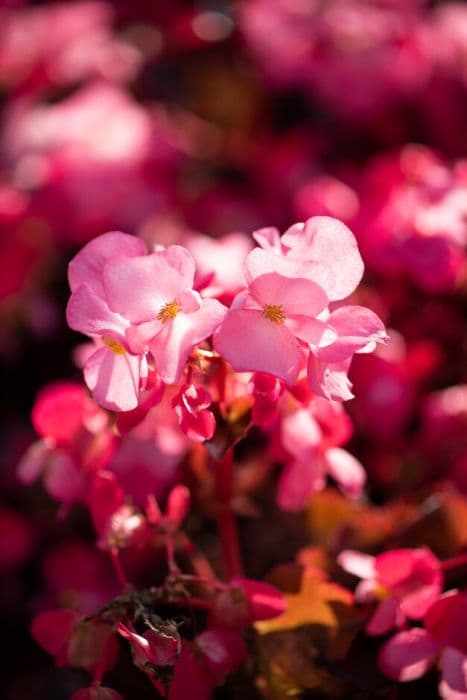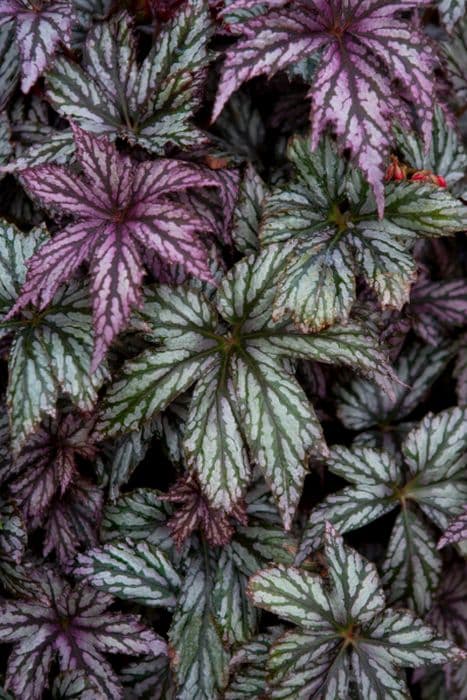Hilo Holiday Begonia Begonia 'Hilo Holiday' (R)

ABOUT
Begonia 'Hilo Holiday' is a visually striking plant with foliage that can catch anyone's eye. The leaves are the most distinctive feature, showcasing lush, wavy edges that add to their ornamental appeal. Each leaf is uniquely patterned with rich green and silver markings that intertwine across the surface, making a tapestry of color that glistens in the light. The undersides of the leaves are equally attractive, often displaying a reddish hue that contrasts beautifully with the green shades above. During its blooming period, Begonia 'Hilo Holiday' produces clusters of flowers that emerge on tall stems above the foliage. The flowers themselves are delicate, with a soft color that can range from white to pale pink. Their gentle appearance creates a lovely balance against the boldness of the leaves. The overall appearance of Begonia 'Hilo Holiday' is one of lushness and vibrant detail. The interplay of colors and textures between the foliage and flowers provide a sense of depth and complexity, making it a popular choice for gardeners and houseplant enthusiasts seeking a living decoration with a tropical flair. This Begonia variety also has a structurally appealing habit, with leaves that grow symmetrically from a central point, creating a rounded, full appearance. The plant combines both the intricate patterns of the leaves and the simple beauty of its flowers, presenting a captivating display that can enhance the aesthetic of any space it occupies.
About this plant
 Names
NamesFamily
Begoniaceae
Synonyms
Hilo Holiday Begonia
Common names
Begonia 'Hilo Holiday'
 Toxicity
ToxicityTo humans
Begonias, including the Begonia 'Hilo Holiday', contain oxalate crystals that can be irritating to the mouth and gastrointestinal tract if ingested. In humans, symptoms of begonia poisoning may include a burning sensation in the mouth, tongue, and lips, swelling of the mouth and throat, difficulty swallowing, and possible vomiting. Skin contact with the sap may also result in irritation or a rash in sensitive individuals.
To pets
Begonias, including the Begonia 'Hilo Holiday', are also toxic to pets due to the presence of insoluble oxalates. If a pet ingests parts of the plant, symptoms may include oral irritation, drooling, vomiting, and difficulty swallowing. In severe cases, ingestion can lead to more serious symptoms such as pawing at the face, lack of appetite, and in very rare cases, difficulty breathing if throat swelling occurs. Pet owners should be cautious and prevent pets from accessing begonias.
 Characteristics
CharacteristicsLife cycle
Perennials
Foliage type
Evergreen
Color of leaves
Variegated
Flower color
Varies
Height
1-2 feet (30-60 cm)
Spread
1-2 feet (30-60 cm)
Plant type
Herb
Hardiness zones
10
Native area
Central and South America
Benefits
 General Benefits
General Benefits- Ornamental Appeal: The Begonia 'Hilo Holiday' offers vibrant foliage and flowers, adding a pop of color to gardens and indoor spaces.
- Low Maintenance: This plant is relatively easy to care for, requiring minimal attention beyond basic watering and occasional fertilizing.
- Drought Tolerant: Once established, it can tolerate short periods of drought, making it suitable for drier climates or for gardeners who prefer plants that do not require daily watering.
- Suitable for Containers: It grows well in pots, making it an excellent choice for balconies, patios, or indoor plant collections.
- Shade Loving: It prefers shaded areas, making it an ideal plant for garden spots that receive limited sunlight or for brightening up low-light areas indoors.
- Season-Long Blooming: It often blooms from spring to fall, providing long-lasting visual interest and aesthetic appeal.
- Non-Invasive: The plant typically doesn't spread beyond its intended area, making it a good neighbor to other plants in gardens or landscape settings.
 Medical Properties
Medical PropertiesThis plant is not used for medical purposes.
 Air-purifying Qualities
Air-purifying QualitiesThis plant is not specifically known for air purifying qualities.
 Other Uses
Other Uses- Begonia 'Hilo Holiday' can be used in terrariums due to their high humidity requirements and compact growth.
- Their brightly colored leaves can be utilized in photography projects as a natural backdrop or an intriguing subject matter.
- The waxy leaves of the Begonia can be used in artistic impressions, like leaf rubbing or printing to create patterns and designs.
- As an educational tool, the Begonia can be used to teach about plant propagation through leaf-cutting techniques.
- The Begonia can be incorporated into themed gardens such as fairy or miniature gardens due to their petite size and vibrant appearance.
- Use the plant as a living mulch in garden beds to help retain soil moisture and suppress weeds, thanks to its dense foliage.
- The flowering Begonia can add an aesthetic appeal to workshops or creative spaces, inspiring color schemes and creative design.
- These plants can act as an indicator for over-watering in gardens; their sensitive roots help to signal when there's excess moisture.
- In culinary contexts, their flowers can be used as a colorful garnish on salads and desserts, though they should not be consumed in large quantities.
- The plant can serve as a gift that symbolizes the receiver's uniqueness and resilience, given its unique appearance and hardiness.
Interesting Facts
 Feng Shui
Feng ShuiThe Begonia is not used in Feng Shui practice.
 Zodiac Sign Compitability
Zodiac Sign CompitabilityThe Begonia is not used in astrology practice.
 Plant Symbolism
Plant Symbolism- Cautiousness - Begonia often symbolizes a need for caution; "Hilo Holiday" Begonia, with its vibrant colors, can remind us to proceed with care in new or uncertain situations.
- Uniqueness - The "Hilo Holiday" variety of Begonia, with its specific pattern and form, stands out from other plants, representing individuality and uniqueness.
- Harmony - The begonia is known for its ability to thrive with the right care, suggesting a balanced approach to life's challenges.
- Gratitude - Offering begonia flowers like "Hilo Holiday" can be a way of showing appreciation and thanks.
 Water
WaterThe Angel Wing Begonia should be watered when the top inch of soil feels dry to the touch, which typically means watering approximately once a week. To water the plant, apply water evenly around the base until it begins to drain from the bottom of the pot, ensuring the plant receives a thorough soaking. Avoid letting the plant sit in standing water, as this can lead to root rot. During the growing season, in spring and summer, you might need to water more frequently, while in fall and winter, reduce watering. Depending on the environment's humidity and temperature, the plant may need around 8 to 16 ounces of water each time.
 Light
LightAngel Wing Begonias thrive in bright, indirect light. The best spot for this plant is near an east or north-facing window where it can receive ample light without being exposed to harsh direct sunlight, which can scorch its leaves. However, some gentle morning sun is beneficial and can promote vibrant leaf coloration and flowering.
 Temperature
TemperatureAngel Wing Begonias prefer a warm climate and perform best in temperatures ranging from 60 to 75 degrees Fahrenheit. They should be protected from temperatures below 58 degrees Fahrenheit as cold temperatures can damage the plant. Avoid placing the begonia in areas with cold drafts or sudden temperature changes for optimal growth.
 Pruning
PruningPrune your Angel Wing Begonia to maintain its shape and encourage bushier growth. It's best to prune in the spring when the plant is coming out of its dormant winter period. Remove any dead or dying leaves and stems, and trim back leggy growth to promote more branching. Pruning can be done every few months as needed to keep the plant looking its best.
 Cleaning
CleaningAs needed
 Soil
SoilThe best soil mix for a Hilo Holiday Begonia should be light, well-draining, and rich in organic material. A mix of peat, pine bark, and perlite in equal parts is often recommended. The ideal soil pH for Hilo Holiday Begonia should be slightly acidic to neutral, around 6.0 to 7.0.
 Repotting
RepottingHilo Holiday Begonia should generally be repotted every one to two years, or when you notice that the plant has outgrown its current container. It is best to repot in spring or early summer when the plant is entering a period of active growth.
 Humidity & Misting
Humidity & MistingHilo Holiday Begonia thrives in high humidity conditions, ideally between 50-60%. It may require additional humidity measures like a pebble tray or humidifier if indoor air is too dry, especially in winter.
 Suitable locations
Suitable locationsIndoor
Provide bright, indirect light and keep soil lightly moist.
Outdoor
Shade or semi-shade, sheltered; avoid frost and excessive sun.
Hardiness zone
10-11 USDA
 Life cycle
Life cycleBegonia 'Hilo Holiday' begins its life cycle from seed or vegetative propagation, with seeds germinating in warm, moist soil and cuttings rooting in similar conditions. The germinated seed or rooted cutting then grows into a juvenile plant, developing leaves and a root system. As it matures, the plant forms a bushy structure with characteristic wing-shaped leaves that are often variegated or patterned. The mature Begonia 'Hilo Holiday' then blooms, producing clusters of showy flowers in various colors, typically during summer or the warm months of the year. After the flowering period, this perennial may go through a dormancy phase if exposed to cooler temperatures or adverse conditions, during which growth slows down or stops temporarily. With the return of favorable conditions, the plant will resume active growth, completing its life cycle and potentially producing seeds or being propagated again for new plants.
 Propogation
PropogationPropogation time
Spring-Early Summer
Begonia 'Hilo Holiday', commonly known as Hilo Holiday Begonia, is typically propagated by stem cuttings, a method that is both effective and popular for its simplicity and high success rate. This form of propagation is best done in spring or summer when the plant is actively growing. To propagate by stem cuttings, select a healthy stem about 4 to 6 inches long with at least two sets of leaves. Cut the stem just below a node using a clean, sharp knife or scissors. Remove the lower leaves, leaving only a couple of leaves at the top, and dip the cut end into rooting hormone to encourage root development. The cutting can then be inserted into a moist potting mix, ensuring at least one node is buried where roots will form. The pot should be placed in a warm location with bright, indirect light and kept consistently moist until new growth indicates the cutting has successfully rooted, typically in a few weeks.





![Begonia [Devotion]](/_next/image?url=https%3A%2F%2Fplants-admin.emdemapps.com%2Fimages%2Fplants%2F%2Fimages%2F604b58183573b.png&w=640&q=75)



